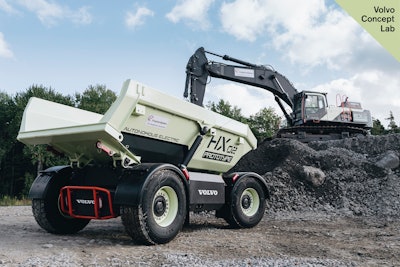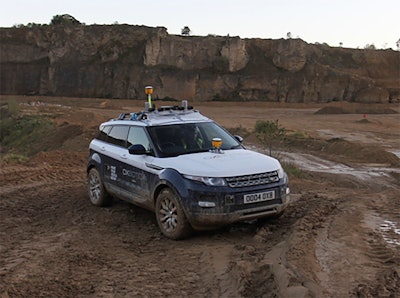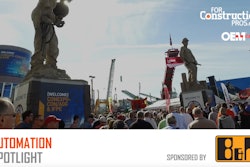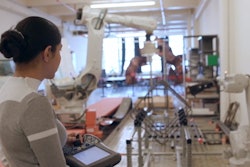
Increasing automation is met with excitement and fear in equal measure. But the potential benefits of autonomy are enormous, says Professor Paul Newman, co-founder of autonomous vehicle software company Oxbotica, and a professor based at Oxford University in the UK.
Newman is also the director of the Oxford Robotics Institute, as well as the BP Professor of Information Engineering at the University of Oxford, UK, and inventor of techniques that allow machines to know where they are, what surrounds them and what they should do next. Speaking on behalf of Volvo Construction Equipment, he shares what automation might mean in terms of construction equipment.
The urge to automate functions in construction equipment is fundamentally about “supercharging” people, says Newman. “It is about humans doing more because machines can do more – because of the way they operate,” he asserts.
“The way machines and vehicles operate is already changing,” he adds. “But for full autonomy, we need to trust machines to be able to operate safely and effectively by themselves, with no dependence on infrastructure, no dependency on any external systems, no beacons, no cables, no markers, no white lines, no dependency on roads, not even dependency on GPS. When this is achieved all machines can work better for us.”
Construction Industry Must Prepare for High-tech Disruptions
What’s Driving Autonomy?
According to Newman, software is driving the increase in mobile machine autonomy.
“Sensors are important and there’s lots of interesting sensor technology coming through,” he comments. “But the golden stuff is the algorithms – the way in which machines can understand space, the structure of space, the work space. How things are moving, what’s in them, the ability to take various sensor streams and for the machine to say: ‘Aha! I know where I am, what’s around me and what I should do next’. Those are the three pillars of autonomy and get answered by software and algorithms.
“Machines can learn, they have the optimization, the estimation and the algorithmic ability to operate at high speeds and in the real world – the ability to process streams of data from multiple sensors and think about redundancy and safety all at the same time,” he continues. “That’s the greatest thrill of working in this area – getting robots and machines to work out in the wild, in the mud, in the rain and in the glaring sun.”
Volvo Construction Equipment Reveals Prototype Autonomous Machines
 Self-driving technology is an "enabler," says Professor Paul Newman.
Self-driving technology is an "enabler," says Professor Paul Newman.
That’s not to say there will be no accidents. “There should be very few of them, but we should admit that there will be some accidents,” Newman acknowledges. But they won’t be the same kinds of accidents that occur when a human is in control. “Something like 80% of accidents on roads are caused by failings that computers never, ever have. Accidents are often caused by boredom and distraction. Autonomy can cut those sorts of accidents to zero.”
It can also cut the learning curve for equipment operation. “Human operators take a long time, years even, to become expert in driving their machines. But construction vehicles can be programmed ahead of their first day on site with all the data and learnings of all other machines that preceded them,” says Newman.
Automation may lower owning and operating costs, as well. “Potholes, for example, in off-road applications can cause all kinds of trouble. But the machine knows they’re coming, it knows they’re being made. So, it moves slowly to the side, which means the tires last longer,” Newman explains. “The controlled acceleration and deceleration of these vehicles massively reduce fuel costs."
Awareness around the site is another factor. “Autonomous machines can work in complete darkness. Vehicles that are not being dispatched can turn themselves off,” says Newman. “As these vehicles move around the site, they’re perceiving their world, but at the same time they’re doing full-scale asset monitoring of the facility.”
The Human Factor
While the machines drive themselves, humans are still in the equation when it comes to autonomy – but their roles are likely to change. For example, autonomy can allow an operator to drive multiple machines rather than one at a time. There will also be a need to keep these high-tech machines in peak operating condition.
“Jobs will change and new roles will be created gradually over time,” says Newman. “In construction and mining, we’ll have whole crews of people who are upskilled to look after the autonomous machines."
A Study of the Impact of Autonomous Technology
But such changes won't occur overnight. “There are certain tasks that are, for the moment, beyond what machines can do. Take a very skilled excavator operator and the precise and delicate ways they control the buckets. It’s extraordinary,” Newman says. That same highly skilled operator gets asked to do highly repetitive, “dreary” tasks, which he sees as a waste of human potential. “We might say there are things which we would want humans to do, and others that a machine can do ceaselessly in the middle of the night in the dark. It’s about empowering the genius of the human brain by taking away the monotonous tasks.
“Machines and humans will work together for some time to come,” he comments. “It will be a long time before anything comes near to the extraordinary skill of a human being. But then there are some roles that are simple and repetitive work site tasks that autonomy systems can do better and more safely.”
The industry remains a long way off from being able to utilize autonomous technology in all places, times and applications. “But for clearly understood and defined applications,” says Newman, “we are able to install, train up and deliver machines today.”
More Resources:
Caterpillar Autonomous Haul Trucks Point To Construction’s Future
[VIDEO] Built Robotics Delivers Robotic Upgrades for Construction Equipment


















